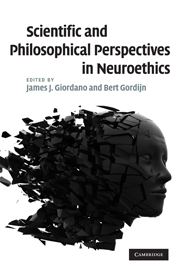Book contents
- Frontmatter
- Contents
- List of contributors
- Preface
- Acknowledgments
- Introduction
- 1 Developments in neuroscience
- 2 The origins of the modern concept of “neuroscience”
- 3 On the cusp
- 4 The mind-body issue
- 5 Personal identity and the nature of the self
- 6 Religious issues and the question of moral autonomy
- 7 Toward a cognitive neurobiology of the moral virtues
- 8 From a neurophilosophy of pain to a neuroethics of pain care
- 9 Transplantation and xenotransplantation
- 10 Neurogenetics and ethics
- 11 Neuroimaging
- 12 Can we read minds?
- 13 Possibilities, limits, and implications of brain-computer interfacing technologies
- 14 Neural engineering
- 15 Neurotechnology as a public good
- 16 Globalization: pluralist concerns and contexts
- 17 The human condition and strivings to flourish
- 18 The limits of neuro-talk
- Afterword
- Index
7 - Toward a cognitive neurobiology of the moral virtues
Published online by Cambridge University Press: 07 May 2010
- Frontmatter
- Contents
- List of contributors
- Preface
- Acknowledgments
- Introduction
- 1 Developments in neuroscience
- 2 The origins of the modern concept of “neuroscience”
- 3 On the cusp
- 4 The mind-body issue
- 5 Personal identity and the nature of the self
- 6 Religious issues and the question of moral autonomy
- 7 Toward a cognitive neurobiology of the moral virtues
- 8 From a neurophilosophy of pain to a neuroethics of pain care
- 9 Transplantation and xenotransplantation
- 10 Neurogenetics and ethics
- 11 Neuroimaging
- 12 Can we read minds?
- 13 Possibilities, limits, and implications of brain-computer interfacing technologies
- 14 Neural engineering
- 15 Neurotechnology as a public good
- 16 Globalization: pluralist concerns and contexts
- 17 The human condition and strivings to flourish
- 18 The limits of neuro-talk
- Afterword
- Index
Summary
In the ten years since this chapter was originally written – for an issue of the journal Topoi devoted to the topic of moral reasoning – the hopes expressed in its opening paragraph have been fulfilled beyond even my own fond expectations. Since then, brain imaging has revealed a number of neuroanatomical locations that seem disproportionately active during moral reasoning and various forms of social interaction. At a lower level, neuroethology and neurophysiology have jointly identified several distinct neurotransmitter chemicals that play a major role in long-term pair-bonding, in the establishment of mutual trust and cooperation between individuals, and in the commitment of personal resources to the joint parenting of shared offspring, both in animals and in humans. Beyond this, the role of our so-called “mirror neurons” in comprehending the behavior and the emotions of one's fellow creatures, and in grounding one's capacity for social mimicry, has revealed a major brain mechanism for simultaneously sustaining both social perception and social behavior. And these brain-focussed disciplines have recently been joined by the social sciences from above and by evolutionary biology from below, yielding a multi-level and multidisciplinary portrait of our precious capacity for moral cognition. This capacity for morality, it now seems clear, is not unique to the human species; many other creatures display it as well. But none does so as thoroughly and intricately as we humans. It binds us together, and gives us collective (and individual!) wings, to a degree that is downright startling.
- Type
- Chapter
- Information
- Scientific and Philosophical Perspectives in Neuroethics , pp. 146 - 171Publisher: Cambridge University PressPrint publication year: 2010
- 3
- Cited by



